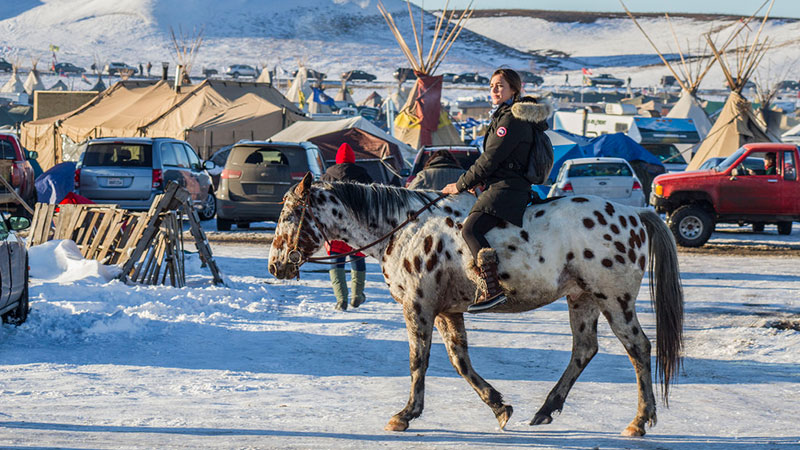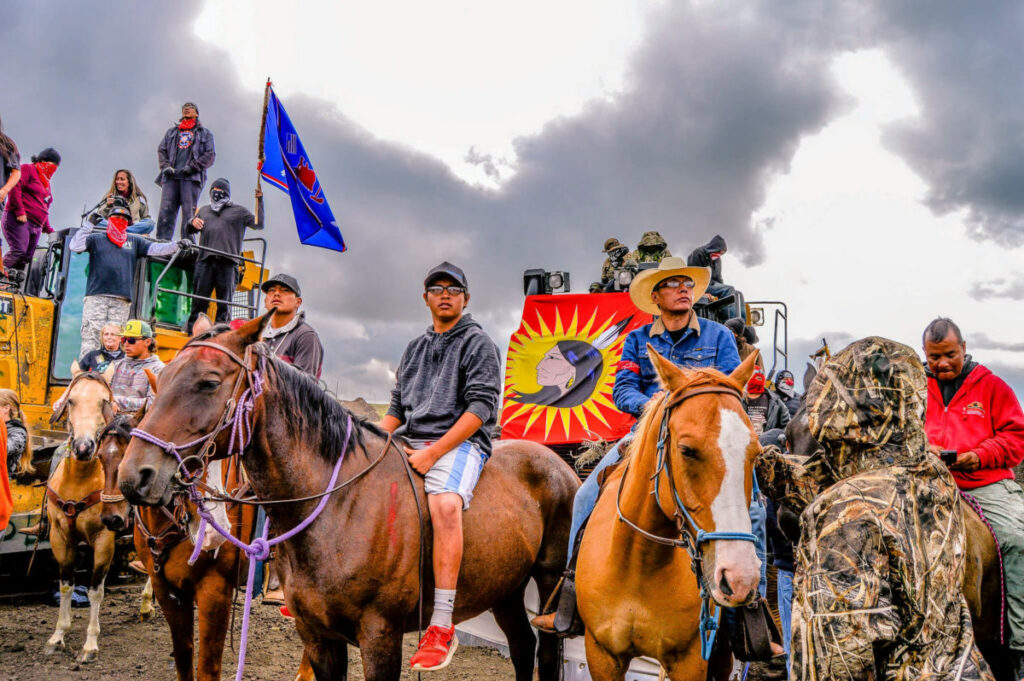SOURCE: Reproduced with permission of Journal of Political Ecology. Book Review: Gilio-Whitaker, Dina. (2019). As long as grass grows: the Indigenous fight for environmental justice, from colonization to Standing Rock. Boston: Beacon Press.
Dina Gilio-Whitaker (Colville Confederated Tribes) is the policy director and a senior research associate at the Center for World Indigenous Studies and teaches American Indian Studies at California State University San Marcos. She is the coauthor, with Roxanne Dunbar-Ortiz, of “All the Real Indians Died Off” and 20 Other Myths About Native Americans. She lives in San Clemente, California.]
The body of literature exploring the complexities and challenges of environmental justice is rich, extensive, and ever-growing, as is work on the Native American experience. However, no author has yet managed to weave a comprehensive history of settler colonialism from an indigenous perspective into the framework of the ongoing struggle for environmental justice. That is what Dina Gilio-Whitaker accomplishes in her new book As long as grass grows: the Indigenous fight for environmental justice, from colonization to Standing Rock. This ambitious work makes a strong case for an expansion of the contemporary environmental justice movement, to accommodate the unique experience of people whose sovereign existence in North America preceded the United States Constitution.

Gilio-Whitaker (Colville Confederated Tribes), is a Lecturer of American Indian studies at California State University San Marcos, USA; a consultant for tribal and environmental issues; and co-author of “All the real Indians died off” and 20 other myths about Native Americans (Dunbar-Ortiz and Gilio-Whitaker 2016). She is also an accomplished journalist whose first-hand reporting on the 2016-2017 Standing Rock resistance in North Dakota, and other environmental news stories brings a sense of urgency to the narrative. She examines Standing Rock as the latest in a long line of environmental justice struggles on American Indian land that require “the use of a different lens, one with a scope that can accommodate the full weight of the history of settler colonialism, on one hand, and embrace differences in the way Indigenous peoples view land and nature, on the other” (p. 12). The book addresses the central question, “What does environmental justice look like when Indigenous peoples are at the center?”(p. 13), especially given that “to be American Indian today is to have survived a holocaust of a very particular kind, one whose evidence is everywhere, all the time” (p. 129).
As long as grass grows covers a wide political and ecological territory while exploring themes of white supremacy and “structural genocide”, treaty rights and sovereignty, settler colonialism and decolonization, the “Faustian bargain” of resource development on tribal land, attempts at ecological and cultural restoration, and Indigenous concepts of rights of nature. The story begins at the “water-protector” camps in North Dakota, where Native American activists with growing support from environmentalists and everyday citizens are resisting the construction of a pipeline through the sacred lands of Standing Rock. Gilio-Whitaker uses that powerful opening scene to launch her far-reaching inquiry into U.S. history from the perspective of “native peoples… fighting against the whims of the State not only to protect their lands but also for their continued existence as nations” (p. 24).
The narrative of the Standing Rock resistance transitions into a discussion of environmental justice theory from a Native American perspective that emphasizes sovereignty. This is the key concept that in Gilio-Whitaker’s view differentiates the Native American experience from that of other marginalized groups who struggle against environmental racism. As Gilio-Whitaker explains, “Federal law has long recognized the inherent sovereignty of Native nations based on treaty relationships, but it is a limited form dictated by legal doctrines as imagined by the U.S. Supreme Court” (p. 25). The process of moving closer to true sovereignty is the process of decolonization, seeking to balance out a power relationship of settler domination. As an example of how far that discussion has progressed (and the shortcomings that remain), Gilio-Whitaker analyzes a document commissioned by the Environmental Protection Agency, titled Recommendations for fostering environmental justice for Tribes and Indigenous Peoples (2013). On the one hand, this report documents the lingering impacts of 500 years of settler colonialism and suggests strategies to address those harms. On the other hand, the recommendations remain non-binding and essentially a facade “to cover for the more standard project of the State to hamstring Indigenous peoples’ rights to self-determination” (p. 32).

The full extent of the State’s project to hamstring the rights of Indigenous people in the U.S. becomes clear in Chapter 2, provocatively titled “Genocide by any other name: a history of Indigenous environmental injustice.” This unflinching examination of settler colonialism and its wrongdoings exposes familiar tropes such as the “pristine” American West and “vanishing” populations of Native Americans while delivering difficult truths about forced relocation, structural genocide, and slavery. In addition to the well-known tragedies of the Long Walk and the Trail of Tears, Gilio-Whitaker also weaves in the less familiar plights of the Pomo of Northern California, the Paiutes of Southern Oregon, the millions of people held captive in a system of Indigenous slavery dating back to 1492, and the 12,000 Native people who collectively lost 1,369,000 acres (554,000 ha) of Indian lands under tribal “termination” policies of the 1950s. Gilio-Whitaker posits that “Native identities are formed against a backdrop of historical tragedy and ongoing injustice” and “the struggle to defend what remains of ancestral lands, territories, resources, and cultures” (p.49).
Gilio-Whitaker’s analysis is particularly strong in Chapter Three as she deconstructs the Industrial Revolution and its devastation of Native American lands, waters, and cultures. Gilio-Whitaker frames the rise of the railroads, oil fields and hydropower dams, the slaughter of the buffalo and the toxification of Indian lands and waters, as parts of a violent conquest driven by a strongly held sense of white supremacy over Native Americans whom U.S. Supreme Court Chief Justice John Marshall described as “people over whom the superior genius of Europe might claim an ascendancy” (p. 56). This racist power dynamic drove the flooding of ancestral lands, the clear-cutting of long-protected forests, and the poisoning of Indian lands and waterways for uranium mining and fossil fuel extraction. As Gilio-Whitaker writes, “The technological innovations and Indian land cessions that made westward movement possible have always benefitted settler populations at the expense of Indigenous populations” (p. 73).
Unfortunately, the inequalities between settlers and Indigenous peoples in the U.S. apply not only to economic gains from industrialization but also to environmental “preservation” initiatives such as national parks, which protected areas as “untrammeled wilderness” while excluding Indigenous peoples who had lived in these landscapes for thousands of years. Resulting tensions from forced removal, coupled with the prevailing notions of white supremacy behind the preservation movement of the 19th century and even of revered naturalists such as John Muir, help explain the difficult historical relationships between environmentalists and Indigenous activists, the subject of Chapter Five. This eye-opening critique of the roots of American environmentalism will make difficult reading for non-indigenous people who identify more strongly with nature than with consumerism. But it is a critique worth understanding, given the importance of forging coalitions between environmentalists and Native Americans with shared interests in resisting the worst excesses of industrialized capitalism.

Gilio-Whitaker shifts from the grim legacy of the past to the challenges of the present and the opportunities for the future in the second half of her book, focusing on health and diet, women’s rights, and spirituality and sacred places. She traces a clear connection between the injustices of the past and the disturbingly poor health statistics of the present, noting that Indigenous people historically relied on more than 2,000 types of plant-based foods prior to the loss of traditional lands and the rise of industrial farming and commodified bulk food items. She praises a growing “food sovereignty” movement to reduce obesity, diabetes, and depression by restoring traditional native diets featuring wild rice in the northern lake country, wild salmon in the Pacific Northwest, and many native plants long missing from increasingly commodified diets. She also notes with a sense of hope that Native American culture is typically matrilineal with equitable distribution of power between genders, and many of the strongest Indigenous activists have been and continue to be women. In her view, resisting the patriarchal influences of settler culture and returning to the values of matrilineal heritage has invigorated the indigenous justice movement. A similar sense of optimistic potential results from a movement across numerous tribes to return to spiritual connections with sacred sites in particular, and with nature in general. Gilio-Whitaker argues that Indigenous people stand alone in the environmental justice movement due to their long-standing, profoundly spiritual, and cultural connection to nature and non-human life. That spiritual connection to nature, combined with Native land rights, stores significant potential energy in the legal arena as activists continue to organize in resistance to pipelines and other destructive developments planned for sacred sites from North Dakota to Southern California. These individual struggles tie into a broader global struggle to incorporate ancient indigenous belief systems into modern jurisprudence. Native people from Wisconsin to New Zealand to India are pursuing environmental justice through the legal framework of “rights of nature,” making the case that long-standing indigenous traditions emphasize human kinship with all life, including non-human life. This progressive movement to expand the “rights of man” to all of nature adds to the growing arsenal of tools to use for righting the wrongs of the past. Gilio-Whitaker predicts optimistically that “the growing sophistication of using education, law, and politics to advance tribal self-determination will continue to build a wall of defense against environmentally destructive corporate and government encroachments” (p. 162).
As long as grass grows is an important and accessible work recommended for students and scholars of political ecology from the undergraduate level up. Gilio-Whitaker’s far-reaching work creates a compelling Journal of Political Ecology Vol. 26, 2019 foundation upon which to add specific examples of the ongoing struggle for environmental justice and indigenous rights during times of anthropogenic climate change. By connecting Native American history with the environmental justice movement in a clear and comprehensive manner, Gilio-Whitaker clarifies the depth of the wrong-doings of the past, while also opening the door to a wide range of opportunities for positive change in the future.
References
Dunbar-Ortiz, R. and D. Gilio-Whitaker. 2016. “All the real Indians died off” and 20 other myths about Native Americans. Boston: Beacon Press.

